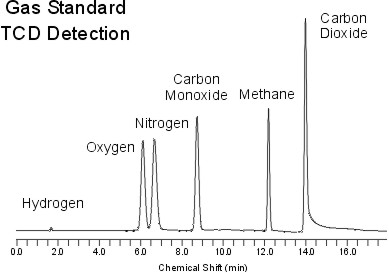


 علم الكيمياء
علم الكيمياء 
 الكيمياء التحليلية
الكيمياء التحليلية 
 الكيمياء الحياتية
الكيمياء الحياتية 
 الكيمياء العضوية
الكيمياء العضوية 
 الكيمياء الفيزيائية
الكيمياء الفيزيائية
 الكيمياء اللاعضوية
الكيمياء اللاعضوية 
 مواضيع اخرى في الكيمياء
مواضيع اخرى في الكيمياء
 الكيمياء الصناعية
الكيمياء الصناعية |
Read More
Date: 10-2-2020
Date: 4-2-2020
Date: 22-4-2020
|
Thermal conductivity detectors (TCD) were one the earliest detectors developed for use with gas chromatography. The TCD works by measuring the change in carrier gas thermal conductivity caused by the presence of the sample, which has a different thermal conductivity from that of the carrier gas. Their design is relatively simple, and consists of an electrically heated source that is maintained at constant power. The temperature of the source depends upon the thermal conductivities of the surrounding gases. The source is usually a thin wire made of platinum, gold or . The resistance within the wire depends upon temperature, which is dependent upon the thermal conductivity of the gas.
TCDs usually employ two detectors, one of which is used as the reference for the carrier gas and the other which monitors the thermal conductivity of the carrier gas and sample mixture. Carrier gases such as helium and hydrogen has very high thermal conductivities so the addition of even a small amount of sample is readily detected.
The advantages of TCDs are the ease and simplicity of use, the devices' broad application to inorganic and organic compounds, and the ability of the analyte to be collected after separation and detection. The greatest drawback of the TCD is the low sensitivity of the instrument in relation to other detection methods, in addition to flow rate and concentration dependency.
Figure 1. Schematic of thermal conductivity detection cell.

Figure 2. Standard Chromatogram of a Mixture of Gases
Chromatogram
Figure 2 represents a standard chromatogram produced by a TCD detector. In a standard chromatogram regardless of the type detector, the x-axis is the time and the y-axis is the abundance or the absorbance. From these chromatograms, retention times and the peak heights are determined and used to further investigate the chemical properties or the abundance of the samples.



|
|
|
|
علامات بسيطة في جسدك قد تنذر بمرض "قاتل"
|
|
|
|
|
|
|
أول صور ثلاثية الأبعاد للغدة الزعترية البشرية
|
|
|
|
|
|
|
مدرسة دار العلم.. صرح علميّ متميز في كربلاء لنشر علوم أهل البيت (عليهم السلام)
|
|
|